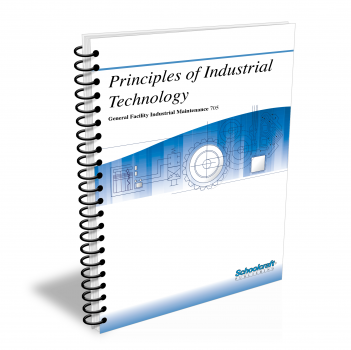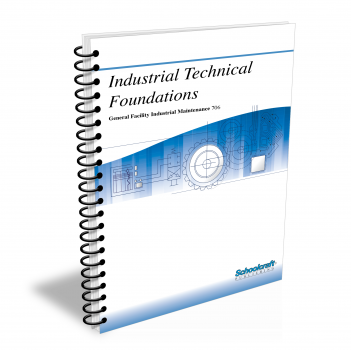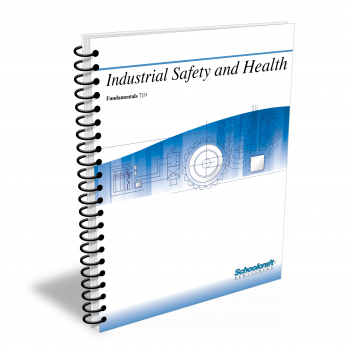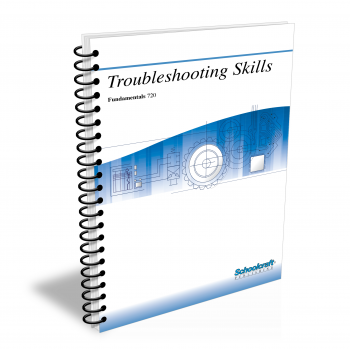Basics of Industrial Maintenance
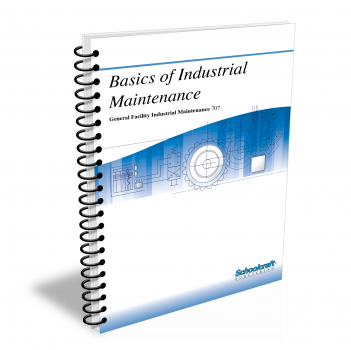
Course Number: 707
The Basics of Industrial Maintenance textbook covers safety, electricity, hydraulics, pneumatics, lubrication, and systems maintenance and related topics, this is our most comprehensive offering in this area. Also suitable as a general overview or per-requisite for industrial technology/maintenance programs with an electromechanical slant.
Does your curriculum require additional topics not included in this textbook? Build a customized version of the Basics of Industrial Maintenance textbook below.
Recommended Contact Hours – 23
Preview a Chapter
Available Supporting Material
- Table of Contents
- Exam Copies
- Suggested Titles
Table of Contents
Chapter 1: Introduction to Safety
Topics: Responsibility for safety; Unsafe acts and conditions; Recognizing hazards; Types of accidents; Investigation; Handling emergencies
Learning Objectives:
- Define the terms accident and hazard.
- Name and define the four main types of hazards.
- List and define various types of accidents.
- Compare meanings of the terms unsafe act and unsafe condition.
- Name the three ways in which a toxic substance can enter your body.
- List ways in which a company must plan for emergencies.
- Tell the main reason for prompt accident investigation.
Chapter 2: Principles of Electrical Safety
Topics: Importance of electrical safety; Lockout; Power equipment and portable power-tool safety; Personal precautions; Working on electric circuits; Switches; Fuses; Working around motors and other equipment; Protection against accidental grounding; Eye injuries; Fire prevention
Learning Objectives:
- Explain the difference between low voltage and safety low voltage.
- Demonstrate what to do if a person suffers a severe electric shock.
- Explain how to fit an older tool with a three-wire cord.
- List the precautions that apply to personal safety in electrical work.
- List safety devices and apparel to use when working on conductors that may be energized.
Chapter 3: Electrons in Atoms
Topics: Structure of matter and atoms; Electron shells; Transferring charges; Electrical forces and terms
Learning Objectives:
- Describe the structure of an atom.
- Tell the difference between a compound and an element.
- Explain how electrical forces cause objects to attract or repel other objects.
- Describe electron flow.
- State the definition of a cell.
Chapter 4: Current Electricity
Topics: Electric current and energy; Electricity from chemical action; Primary and secondary cells; Batteries; Electricity from electromagnetism
Learning Objectives:
- List the main methods of producing potential difference.
- State the main difference between a primary cell and a secondary cell.
- Explain how to connect cells in parallel and in series.
- Describe how a photoelectric device works.
- Identify potential hazards when recharging batteries.
Chapter 5: Current, Resistance, and Voltage
Topics: Electric current, resistance, and potential difference; Ohm's Law; Resistance and voltage drop; Electrical measurement
Learning Objectives:
- State the characteristics of an electrical conductor and an electrical insulator.
- State the definition of electric current.
- Explain the relationship of potential difference to the flow of electric current.
- State the definition of Ohm's Law.
- Identify the purpose and parts of an ammeter.
Chapter 6: Principles of Hydraulics
Topics: Force, weight, mass, pressure, work, power, and energy; Incompressibility; Nondiffusion; Hydrostatic pressure; Pascal's Law; Fluid power transmission; Bernoulli's principle
Learning Objectives:
- Explain the difference between absolute and gauge pressure.
- Demonstrate how power is calculated.
- Explain Pascal's Law.
- Describe the difference between laminar and turbulent flow.
- Name the main components of a hydraulic system.
Chapter 7: Hydraulic Diagrams
Topics: Definition, kinds, and characteristics of schematics; Lines; Symbols; Flow patterns; Tracing a circuit; Sequence valve circuit
Learning Objectives:
- Name three basic types of hydraulic diagrams, and explain the purposes of each.
- Describe how a valve symbol is constructed.
- List the steps to follow when reading a schematic diagram.
- Identify common hydraulic symbols.
Chapter 8: Maintaining Hydraulic Systems
Topics: Inspections; Maintenance requirements; Fluid level; External leaks; Operating pressure; Fluid quality; Filter maintenance; Reconditioning
Learning Objectives:
- List the major categories of hydraulic system maintenance.
- Name and describe the six essential items in a maintenance file.
- List the steps involved in reconditioning a hydraulic component.
- Explain how to set up a maintenance plan for a typical hydraulic system.
Chapter 9: Principles of Pneumatics
Topics: Fluid power systems; Force, weight, and mass; Pressure; Work and energy; Diffusion and dispersion; Compressibility; Laws of pneumatics; Leverage; Air properties and flow; Bernoulli's Law; Components
Learning Objectives:
- Explain how force is transmitted in a pneumatic system.
- Calculate force and work.
- List two factors that affect the results of pressure calculations.
- Explain pneumatic leverage.
- Briefly explain the physical laws affecting the behavior of a confined gas.
Chapter 10: Pneumatic Systems
Topics: Air supply system; Reciprocating and rotary compressors; Cooling; Compressor maintenance; Air-line filters and lubrication
Learning Objectives:
- Explain the operation of linear actuators-cylinders-in a typical pneumatic circuit.
- Describe the various types of compressors and how they work.
- Define intercooling and aftercooling.
- Describe basic preventive maintenance procedures for compressors.
- List the components of an effective delivered-air system and explain how they work together.
- Describe the three main types of air-line lubrication.
Chapter 11: Systems Maintenance
Topics: Control system maintenance; Cylinder maintenance; Tool maintenance; Logs and records; Automatic recorders and recording charts
Learning Objectives:
- Explain the concept of planned maintenance.
- Describe the basic procedures for maintaining the compressor and other important components in a pneumatic system.
- Describe the maintenance of industrial control circuit components.
- Explain the proper maintenance of pneumatic tools.
- Discuss the various types of maintenance logs and explain what kind of information is recorded in each.
Chapter 12: Bearings and Shafts
Topics: Bearing classification and selection; Shaft materials and stresses; Vibration; Critical speed; Fits and clearances
Learning Objectives:
- Name the two main categories of bearings and cite their advantages.
- Identify bearings by the kind of support they provide.
- Describe the three kinds of stresses acting on shafts.
- Explain natural frequency of vibration and critical speed.
- Name and describe three classes of fits.
Chapter 13: Ball and Roller Bearings
Topics: Ball and roller bearing design; Single-row radial, single- and double-row angular contact bearings; Two-piece, inner-ring bearings; Roller bearings
Learning Objectives:
- Name the three basic ball bearing designs and describe their characteristics.
- Explain the purposes served by the basic roller bearing shapes and their variations in typical applications.
Chapter 14: Principles of Lubrication
Topics: Lubricant classification; Friction; Cooling and sealing action of lubricants; Corrosion prevention; Preventive maintenance
Learning Objectives:
- Define lubrication and describe the four forms of lubricants.
- Discuss the characteristics of static, kinetic, fluid, and rolling friction.
- Explain how a lubricant reduces wear and dampens shock.
- Discuss the cooling action of lubricants and explain how they prevent corrosion.
- Explain the importance of a lubricant's sealing action, and explain how it works.
Chapter 15: Lubrication Management
Topics: Lubrication control; Establishing oiler routes; Coding lubrication points; Computer-managed programs; Installation; Computer reports
Learning Objectives:
- Explain the importance of good lubrication management practices and describe seven different kinds of information that should be included on an equipment lubrication survey form.
- Explain how to set up an oiler route and how to color-code the lubrication points.
- Discuss the considerations involved in establishing and installing a computerized lubrication program.
- Describe the purposes of several types of basic computer lubrication forms and list advantages of expanded programs.
Request Exam Copies
Exam Copies
Ready to see a copy of our textbooks? After selecting which textbooks you’d like to review for your course, you can submit your request by either logging in or creating an account so we know where to ship your exam copies. A representative from Schoolcraft will contact you to confirm and finish processing your request.
Exam copies are always free and yours to keep.
Selected Exam Copies
none selected
* Maximum of five copies can be ordered
